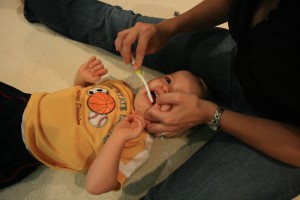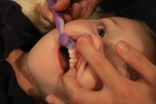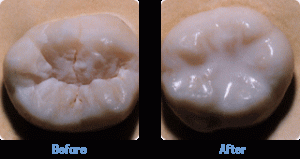General Topics
- What is a Pediatric Dentist?
- Why Are Baby Teeth So Important
- When do the Primary Teeth Develop and Erupt?
- How Can I Help My Child in a Dental Emergency?
- How Safe are Dental X-Rays (Radiographs)
- Toothpaste: When Should We Begin using it, and How Much Should We Use?
- What Can I Do About My Child’s Tooth Grinding at Night?
- Are Thumb-sucking and Pacifier Habits Harmful for a Child’s Teeth?
- What is Pulp Therapy / Nerve Treatment?
- What is the Best Time for Orthodontic Treatment?
- What are some recommended books about kids dentistry?
Early Infant Oral Care
- The First Visit?
- When Do the Baby Teeth Erupt?
- What is ‘Baby Bottle Tooth Decay”, and How Do I Prevent It?
Prevention
- How Do I Take Care of My Child’s Teeth?
- What Type of Diet is Good For My Child’s Teeth?
- What Are The Important Keys To Preventing Tooth Decay?
- What is a Sealant?
- How Do I Know If My Child is Getting Enough Fluoride?
- Does My Child Need a Mouthguards
- What Is Xylitol?
Adolescent Dentistry
For more information on oral health care needs, please visit the website for the American Academy of Pediatric Dentistry.
What Is A Pediatric Dentist?
A pediatric dentist specializes in the treatment of children from infancy through early adulthood and special needs patients.
After receiving their dental degree, they spend an extra 2-3 years in a training program specifically designed to train them on how to manage children and those with special needs.
Children are not just small adults! Their teeth, brains, physiology, and temperament are very different from adults and pediatric dentists are trained to manage all of those differences.
Why Are Baby Teeth So Important?
Primary, or “baby,” teeth are important for many reasons. Not only do they help children speak clearly and chew naturally, they also aid in forming a path that permanent teeth can follow when they are ready to erupt.
When do the Primary Teeth Develop & Erupt?
Primary teeth begin developing between the 6th and 8th week of fetal development. The permanent teeth have begun to form by the 20th week of fetal development. The first primary teeth to erupt are usually the lower central incisors around 6 months of age. The American Academy of Pediatric Dentistry recommends a child’s first dental visit be within 6 months of the eruption of the first tooth or by 1 year of age. All 20 baby teeth usually erupt by 3 years of age. Exact sequence of eruption varies slightly depending on the child. All 20 baby teeth will be replaced by a permanent successor.
The permanent teeth begin to erupt around 6 years of age. The first teeth to erupt are usually the 6 year molars (1st molars) and the lower central incisors. The full permanent dentition is 32 teeth, which includes the wisdom teeth (3rd molars).
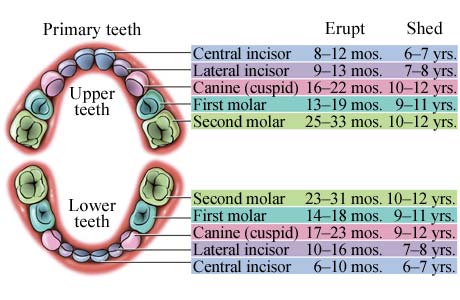
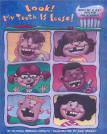 |
Look! My Tooth is Loose! (with 16″x22″ poster and stickers) By Patricia Brennan Demuth Illustrated by Mike Cressy |
How Can I Help My Child in a Dental Emergency?
Toothache:
First, rinse the mouth or affected area with warm salt water. If the face is swollen place a cold compress on the area and call your pediatric dentist immediately. Give children’s Tylenol or Ibuprofen for pain, rather than placing aspirin on the teeth or gums. See a dentist as soon as possible.
Cut or Bitten Tongue, Lip or Cheek:
Quickly apply ice to the affected area to help with swelling. Try to control bleeding by applying firm pressure to the affected area. If simple pressure does not control bleeding, it is important to see a doctor or visit the hospital emergency room.
Knocked Out Permanent Tooth:
Quickly try and find the tooth. Rinse the tooth with water and try to handle the crown, not the root, of the tooth. DO NOT clean off any tissue that may be still attached to the root. If the tooth does not appear to be fractured and the child is cooperative, try and reinsert the tooth into the socket. Have the child bite on a washcloth or gauze to hold it in place. The tooth can also be transported in “Save a Tooth” solution, child’s own saliva, or milk. Time is critical. The child must see a dentist very quickly for the most favorable outcome.
Knocked Out Baby Tooth:
This is usually not an immediate emergency and examination can be delayed until normal business hours. Usually, no treatment is necessary.
Broken, Chipped or Fractured Permanent Tooth:
Contact your pediatric dentist as soon as possible. Early treatment can prevent infection and reduce the need for extensive dental treatment. Sometimes the fractured tooth can be reattached. If possible, save the fractured piece and bring it in to the dentist.
Chipped or Fractured Primary Tooth:
This is usually not an immediate emergency. Contact your pediatric dentist to schedule an evaluation of the affected area.
Severe Head Injury and/or Possible Broken or Fractured Jaw:
Keep the jaw stable and visit the nearest emergency room immediately.
How Safe Are Dental X-Rays (Radiographs)
Radiographs (X-Rays) are a vital and necessary part of your child’s dental diagnostic process. Without them, certain dental conditions can and will be missed.
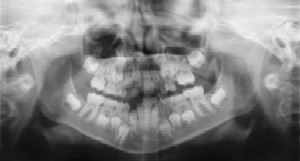
There is very little risk in dental X-rays. Pediatric dentists are especially careful to limit the amount of radiation to which children are exposed. Lead aprons and digital sensors are used to ensure safety and minimize the amount of radiation. Without radiographs, certain dental conditions can and will be missed. If issues are found and treated early, dental care is more comfortable for your child and more affordable for you.
Toothpaste: When Should We Begin Using it & How Much?
The sooner the better! Starting at birth, clean your child’s gums with a soft infant toothbrush or cloth and water. As soon as the teeth begin to appear, start brushing twice daily using fluoridated toothpaste and a soft, age-appropriate sized toothbrush.
Use a “smear” of toothpaste to brush the teeth of a child less than 2 years of age. For the 2-5 year old, dispense a “pea-size” amount of toothpaste and perform or assist your child’s toothbrushing. Remember that young children do not have the ability to brush their teeth effectively. Children should spit out and not swallow excess toothpaste after brushing.
What Can I Do About My Child’s Tooth Grinding at Night?
There are several theories as to why children grind at night. One theory associates grinding with a psychological component. Daily stress at school or home can influence a child to grind their teeth at night. Another theory relates grinding to allergies and pressure in the inner ear at night. By moving the jaw (grinding), the pressure is relieved. No matter the cause, there is not much that can be done until the child is much older.
The good news is that the majority of children outgrow their grinding once the permanent teeth begin to erupt.
Are Thumb-sucking and Pacifier Habits Bad for Teeth?
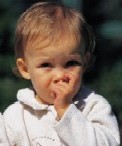 Thumb and pacifier sucking habits will generally only become a problem if they go on for a very long period of time. Most children stop these habits on their own, but if they are still sucking their thumbs or fingers past the age of three, significant changes in the jaws can occur. It is possible that the pediatric dentist may recommend an appliance to help stop the habit. A few suggestions to help your child get through thumb sucking:
Thumb and pacifier sucking habits will generally only become a problem if they go on for a very long period of time. Most children stop these habits on their own, but if they are still sucking their thumbs or fingers past the age of three, significant changes in the jaws can occur. It is possible that the pediatric dentist may recommend an appliance to help stop the habit. A few suggestions to help your child get through thumb sucking:
- Instead of scolding children for thumb sucking, praise them when they are not.
- Children often suck their thumbs when feeling insecure. Focus on correcting the cause of anxiety, instead of the thumb sucking.
- Children who are sucking for comfort will feel less of a need when their parents provide comfort.
- Reward children when they refrain from sucking during difficult periods, such as when being separated from their parents.
- Your pediatric dentist can encourage children to stop sucking and explain what could happen if they continue.
- If these approaches don’t work, remind the children of their habit by bandaging the thumb or putting a sock on the hand at night. Your pediatric dentist may recommend the use of a mouth appliance.
| David Decides About Thumbsucking – A Story for Children, a Guide for Parents by Susan Heitler PHD Paula Singer (Photographer) |
What is Pulp Therapy / Nerve Treatment?
The pulp (nerve) is the most center part of the tooth. It contains blood vessels, nerves and reparative cells. When the cavity of a tooth is into the nerve or, sometimes even when it is close to the nerve, a “pulpotomy” (nerve treatment) must be completed to maintain the vitality of the tooth. Sometimes, a “pulpectomy” is performed and this is just a more extensive version of the pulpotomy. Either treatment is an effort to maintain the tooth as long as possible.
Once the affected nerve tissue is removed, an antibacterial agent is placed to prevent bacterial growth and calm the nerve tissue. The nerve treatment is followed by a permanent restoration, which is usually a stainless steel crown.
What is the Best Time for Orthodontic Treatment?
Pediatric dentists are trained to recognize possible issues with the developing dentition. Early treatment can prevent more extensive dental problems in the future. Some dental malocclusions (bad bites) can be recognized as early as 2-3 years old.
Children have 3 different phases of tooth development. The first phase is all primary (baby) teeth from 2-6 years old. During this time in a child’s life we are concerned with underdeveloped dental arches, premature loss of primary teeth, and harmful habits such as finger or thumb sucking. Treatment initiated during this phase can have great results and may in some cases prevent need for future orthodontic treatment.
The second phase is called “mixed dentition” and this happens from around 6-12 years of age. This phase has both permanent and primary teeth and begins when the 6 year molars and lower central incisors begin to erupt. Treatment concerns and goals during this time of a child’s life are directed at correcting jaw relationships by redirecting growth and aligning teeth that are excessively out of place. When indicated, treatment during this phase is very successful because the hard and soft tissues are very responsive to orthodontic movement.
The last phase of a child’s dentition is when all adult teeth are present and this is when we make the final decision as to whether or not the child would benefit from orthodontic treatment.
The First Visit?
The American Academy of Pediatric Dentistry recommends that a child see the dentist within 6 months of the eruption of the first tooth or no later than age 1. The dentist is able to provide valuable information on diet, hygiene, and answer any questions that parents may have regarding their child’s teeth. We are able to detect possible areas of concern very early and parents are able to go home with information that allows them to better care for their child’s oral health. At the first visit we perform a professional cleaning, exam and fluoride application.
When Do The Baby Teeth Erupt?
The eruption of baby (primary) teeth into the mouth varies greatly between children. Some babies may start getting teeth around 4 months of age and others may not get any teeth until 12-14 months of age. The first teeth to usually appear are the two front lower incisors. Those are followed by the upper incisors and the lateral insicors.
Teething can be unpleasant for some children. We recommend a chilled teething ring and/or an oral analgesic (Children’s Tylenol) when needed. Topical anesthetics, such as baby Orajel, are not recommended due to potential toxicity in very young children.
What is “Baby Bottle Tooth Decay”, and How Do I Prevent it?
Baby bottle tooth decay (also known as early childhood caries) is caused by the frequent and long exposure to sugary liquids. These liquids include, milk (breast and formula), fruit juice, and other sweetened beverages.
Allowing a child to sleep with anything other than water can cause rampant tooth decay very quickly. The last bit of the sugary drink is never swallowed and it will coat the teeth while the child is sleeping. If you are currently allowing your child to sleep with a sugary drink we encourage you to make changes TODAY! You may need to start by diluting the drink over a 1 week period until there is only water in the bottle. It is very likely that your child will be fussy at first, but with time they will be trained to no longer need the drink to get to sleep.
After feedings, you should wipe your child’s mouth with a gauze, washcloth, or soft toothbrush to remove any leftover liquid and plaque buildup. The easiest way to do this is by laying your child on the floor or the couch so you can easily see into the child’s mouth.
How Do I Take Care of My Child’s Teeth
Begin brushing your child’s teeth as soon as they begin to erupt into the mouth. The American Academy of Pediatric Dentistry recommends that children under the age of 2 use a “smear” of fluoridated toothpaste. This amount of toothpaste will allow for optimal fluoride exposure and will not negatively affect the permanent teeth that are developing. From ages 2-6 we recommend a “pea-sized” amount of toothpaste. The toothbrush should be held at a 45 degree angle towards the gumline and moved in a gentle circular motion. Brush all surfaces of the teeth and finish with the tongue.
Floss should be used when you are unable to brush all surfaces of the teeth with the toothbrush. When teeth are touching you cannot get the toothbrush in between them to clean those surfaces. For some children, flossing must begin with the eruption of the 2 central incisors. If your child has spacing throughout the front teeth, then flossing can be postponed until the back teeth erupt and are touching. We recommend using the disposable flossers, as they make it much easier than the long string to floss your child’s teeth. Don’t forget the backs of the last four teeth!
What Type of Diet is Good For My Child’s Teeth?
 Healthy eating habits will promote healthy teeth. Be sure your child has a well balanced diet including fruits & vegetables, dairy, whole grains, protein and water.
Healthy eating habits will promote healthy teeth. Be sure your child has a well balanced diet including fruits & vegetables, dairy, whole grains, protein and water.
Foods that are highly processed contain a high level of refined carbohydrates. Cavity causing bacteria metabolize carbohydrates and create an acid that breaks down the teeth. The more frequently the mouth is exposed to carbohydrates, the more acid it will be exposed to and the more likely cavities are to form.
We recommend snacks such as fruit, low-sugar yogurt, and cheese. Be careful with things that say “100%” or “all natural” fruit. “100% fruit” snacks are not the best to snack on daily because they contain a lot of sugar and are very sticky. Sticky snacks tend to sit in the grooves of the teeth feeding the oral bacteria until the next meal. Also, try to stick with water in between meals. Give milk or watered down juice only at mealtime. Keep in mind that bottled water (unless noted) does not contain fluoride so try and opt for filtered tap water when possible.
What Are The Important Keys to Preventing Tooth Decay?
It is the combination of food (mostly carbohydrates), cavity causing bacteria, and some genetic components that cause tooth decay.
Practice good oral hygiene and teach your children the importance of brushing twice daily. When they are little it is important that you help them get a really good brushing in at night before bed. Try to stick to only water after that last brushing.
Provide healthy options for meals and snacks. We understand that some children need more snacks than others because they don’t eat very much at mealtime, however, it is important to incorporate some low-carbohydrate snacks during the day. Frequency of snacking is one of the most important risk factors in tooth decay.
Take your child to see a dentist every 6 months so early signs of decay can be caught and you can make changes at home to help prevent further progression of the cavity. The dentist can also provide fluoride treatments and sealants to prevent tooth decay.
Lastly, keep your own mouth healthy and don’t share utensils. You can pass cavity-causing bacteria to your child from the day they are born. The more cavities you have the more likely you are to pass on the bacteria.
What is a Sealant?
A sealant is a clear dental material that is placed over the chewing surface of the molars and bicuspids (back teeth). Sealants are approved for use on any tooth with pits and fissures that are prone to decay. Even the smallest toothbrush bristle cannot fit into the depth of the grooves of the teeth. These grooves collect plaque and over time can become a cavity. The application of sealant is fast and comfortable and can effectively protect teeth for many years. All of the sealants we use are BPA free.
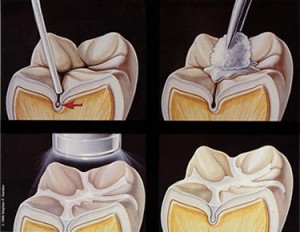 |
|
How Do I Know If My Child Is Getting Enough Fluoride?
The primary source of fluoride is in drinking water. If your child drinks exclusively bottled water or the fluoride in your area is low, they may not be receiving adequate fluoride for the development of their permanent teeth. We may recommend fluoride supplements if your child does not have enough fluoride exposure in their diet.
Be sure to keep toothpaste away from children who may eat it and always use a smear or pea-sized amount until the child is able to spit. Certain foods contain high levels of fluoride, especially powdered concentrate infant formula, soy-based infant formula, infant dry cereals, creamed spinach, and infant chicken products. Please read the label or contact the manufacturer. Some beverages also contain high levels of fluoride, especially decaffeinated teas, white grape juices, and juice drinks manufactured in fluoridated cities.
Does My Child Need A Mouthguard?
When a child begins to participate in organized sports there is a chance of injuries to the teeth and jaws. A custom mouth guard is an important piece of equipment that can protect your child’s smile.
A mouth guard can help prevent injuries to the teeth, gums, lips, face and jaw. Please ask us about our custom mouth guards.
What is Xylitol?
Xylitol is a naturally occurring sugar that can help prevent cavities by preventing acid production in the mouth. The American Academy of Pediatric Dentistry recognizes this fact and does support incorporating Xylitol into daily oral health practices.
Studies have shown that if mothers begin chewing Xylitol gum 3 times a day (after each meal) within 3 months of delivery and continue until the child is 2 years old there is up to a 70% reduction in cavities by the time the child is 5.
Some of the best natural sources of xylitol are fruits, berries, mushrooms, lettuce, and corn cobs. Xylitol gums may be found at some grocery and health food stores. Please ask us about the Xylitol products we have available in the office.
Should I Allow My Child To Get Their Tongue Pierced?
There are several risks involved with oral piercings which include broken or cracked teeth, blood clots, blood poisoning, heart infections, brain abcess, nerve disorders, receding gums and scar tissue. The mouth has millions of bacteria and infection is a very common complication of oral piercings. Follow the guidelines of the American Dental Association and skip the mouth jewelry.
Tobacco is Bad News
Tobacco in any form can jeopardize your child’s health. Discuss with your child the risks of all types of tobacco.
If your child is a tobacco user you should watch for the following signs and symptoms as they may be signs of oral cancer:
- A sore that won’t heal.
- White or red leathery patches on the lips, and on or under the tongue.
- Pain, tenderness or numbness anywhere in the mouth or lips.
- Difficulty chewing, swallowing, speaking or moving the jaw or tongue; or a change in the way the teeth fit together.


